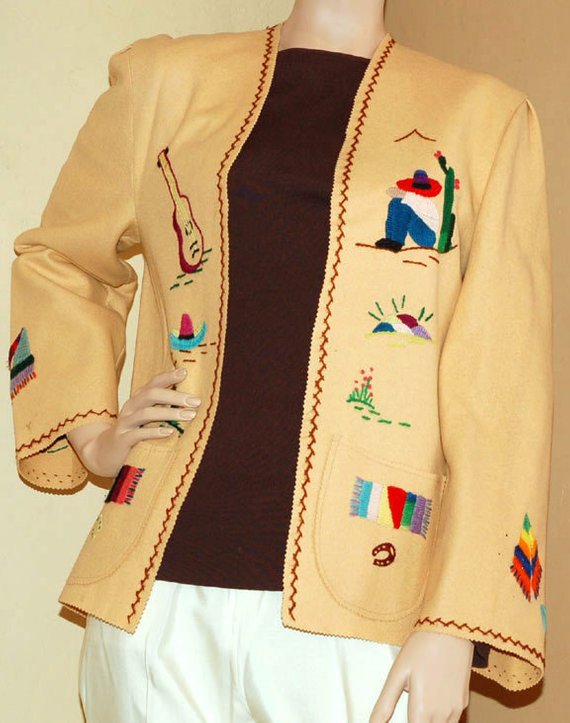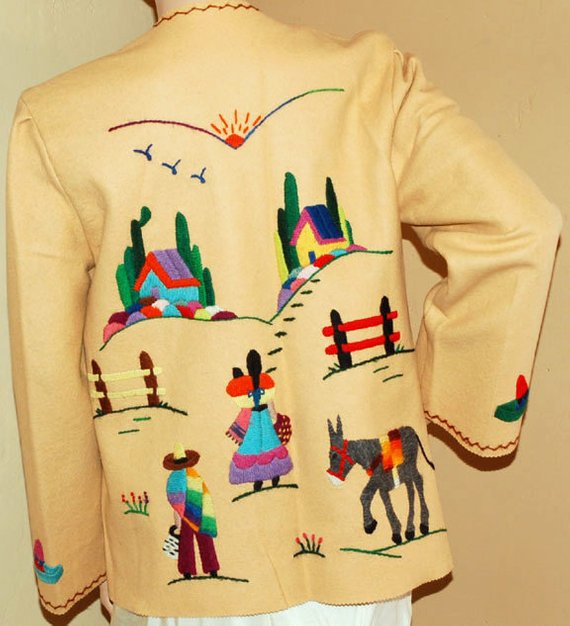I was searching the Internet for inspiration to embroider an old, black wool poncho that I had tired of, and I came across the little-known fad of Mexican tourist jackets from the 1940s and ’50s. Adorned with colorful folkloric scenes, these embroidered wool jackets were made in Mexico for American tourists. Unlike Mexican floral shirts, which were primarily intended for Mexicans but eventually caught on in the U.S., I think it’s safe to assume that Mexicans never wore these garments. Funnily, my Mexican husband had never heard of the Mexican tourist jacket, despite his keen interest in Mexican folk art.
Courtesy Lucky Star Gallery
Courtesy Lucky Star Gallery
As you can see, the jackets are made with care, featuring lively donkeys, cacti, flowers and village scenes. A popular trope is the couple engaged in play and dance. I particularly like that the embroidery in these jackets is kind of rough, with the artist using big stitches with thick wool thread, as opposed to thinner cotton or silk thread, which would have allowed for more detail. This gives the jackets the kind of folksy flair that I strive for in my quilts. That the jackets often feature animals helps, of course.
Courtesy Petrune
On the other hand, the imagery raises a host of questions. What was it that attracted Americans to these garments? What kind of fantasies did they conjure up? And would it be insensitive to wear them today?
Life in America during that time was conservative and constrained, particularly for women, the target consumer of these souvenirs. This attire might have allowed the female wearer to express a desire that had been thwarted. As such, the jackets are a testament to an environment that was not only warmer, both physically and emotionally, but also more colorful and passionate. Maybe the jacket allowed American women to feel free and liberated, if just for a moment. Or maybe it was a convenient way to show off one’s worldliness? Like, “Look, I have been to exotic places and I am carrying a bit of their effervescence with me.” American couture of the time might have looked bland and inhibited in comparison.
Courtesy Ohio Vintage JM
A quick search for “embroidered Mexican tourist jacket” on Etsy yields 41 results. The examples range in price from $30 and $215. Wondering if anyone shared my concern about the imagery, I quickly found out that there are, inevitably, two camps. On the one side are people like Atomic Redhead who, on her fashion blog, admits that she’s attempting to own a Mexican jacket in every color. “[I]t’s kind of hard to have one jacket that goes with every outfit, but since these jackets often have so many colors, it makes it easy to pair it with anything!” She writes. In her view, wearing a Mexican jacket is celebrating Mexican culture.
Courtesy Petrune
The other camp argues that it is simply wrong to appropriate and exploit the styles of indigenous people, particularly if one knows nothing about their culture. Still, some people are more nuanced in their judgment, pointing out that these jackets were specifically made for Americans, providing income, pride and exposure to the women who made them. For the most part, they aren’t mean caricatures; buying and wearing a jacket like this honors the women’s labor and creativity. This, they say, differs from American companies who replicate and exploit someone else’s culture without giving back. (The popular Pendleton blankets have been in the crossfire for exactly that reason.)
But when it comes to cultural appropriation I wonder where the line is drawn. One perceptive comment, featured on Gertie’s Blog For Better Sewing, mentions our love for French couture. If I love to wear Paul Gautier, does that mean I, who may have never set foot on France, am appropriating French culture? Or better yet, was it insensitive of me to start cooking Mexican food before I had ever been to Mexico? Granted, my husband grew up in Mexico, but he can’t cook and, at the beginning, my food was far from authentic.
As always, I think, the devil is in the detail. Personally, I would shy away from wearing a jacket that features a Mexican in a sombrero sleeping under a cactus. This kind of stereotype is a personal insult to my hard-working Mexican husband and my in-laws, not to mention millions of other Mexicans. But is it wrong to find excitement and inspiration in the jackets’ floral patterns and their vibrant depiction of couples dancing among cacti? I don’t think so. In my book, nobody owns a dancing couple, or a cactus for that matter.
Courtesy Trunk of Dresses
For now, I have decided on a different kind of embroidery for my poncho. Today the new Boden catalog arrived. It features wool sweaters with the Norwegian designs that are ubiquitous this winter. However, instead of reindeers, my poncho will feature camels that dance around my shoulders. If I’m not too lazy, I might add some “Florentine Embroidery.” Legend has it that the design was introduced by a Hungarian bride who married into the Medici family in Florence in the 15th century. The pattern has been found in Florence in great abundance ever since, making the question of appropriation moot by this point.






